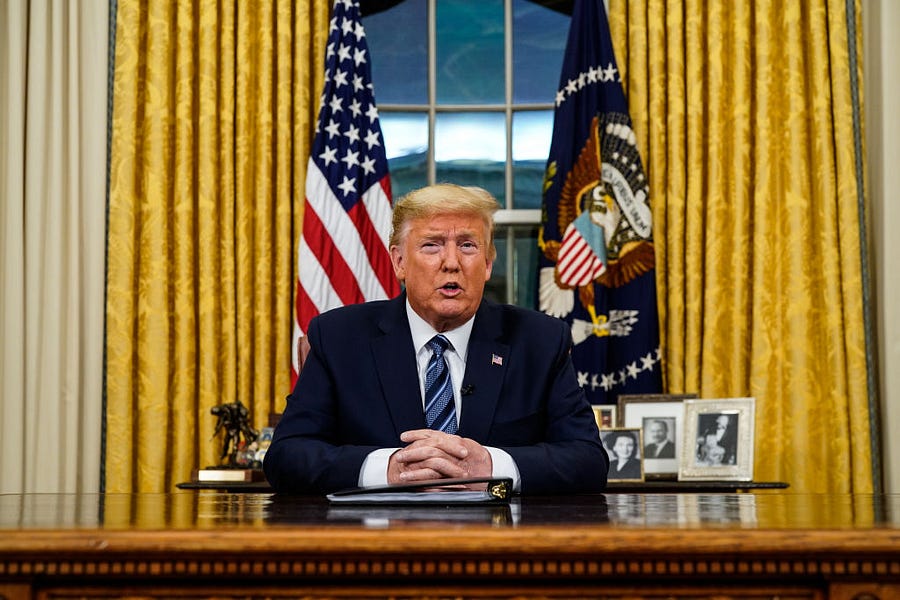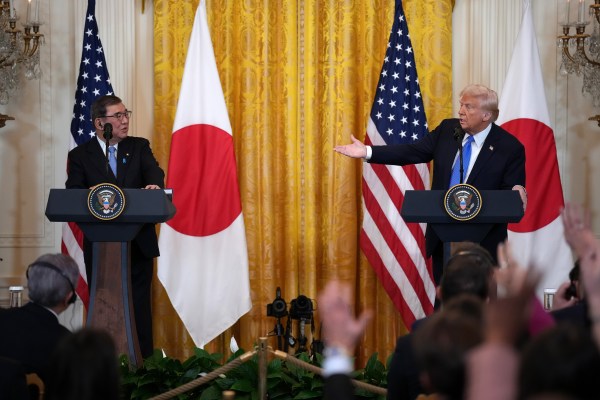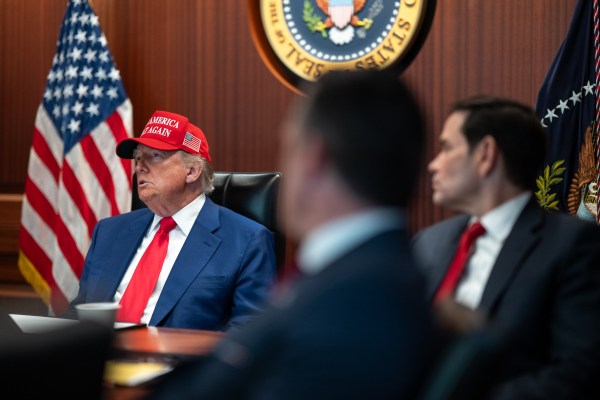Wednesday was an undeniable inflection point in America’s fight against coronavirus. The number of confirmed patients in the U.S. surged past 1,000, while Dr. Anthony Fauci, who heads the National Institute of Allergy and Infectious Diseases, warned Congress that “it’s going to get worse.” The World Health Organization declared the outbreak a “global pandemic.” News broke of the first celebrities to get the virus: actors Tom Hanks and Rita Wilson and Utah Jazz center Rudy Gobert. The NBA suspended its season until further notice. And the stock market, which had been bouncing around uncertainly for days, seemed finally to settle on pessimism: A 1,000-point drop put the U.S. into a bear market for the first time in more than 11 years.
It appears finally to have been enough for Donald Trump. The president, who in recent weeks has frequently downplayed the severity of the coronavirus, addressed the nation about the crisis Wednesday night. In his primetime speech, the president offered a slew of policy changes and proposals to combat the virus and mitigate its effects on the economy. And perhaps more important, he urged the viewing public to take the threat of the coronavirus calmly, but seriously, and to follow expert recommendations designed to slow the disease’s spread.
“For the vast majority of Americans, the risk is very, very low,” Trump said. “Young and healthy people can expect to recover fully and quickly if they should get the virus. The highest risk is for elderly population with underlying health conditions. The elderly population must be very, very careful. In particular, we are strongly advising that nursing homes for the elderly suspend all medically unnecessary visits. In general, older Americans should also avoid nonessential travel in crowded areas.
“We have issued guidance on school closures, social distancing, and reducing large gatherings. Smart action today will prevent the spread of the virus tomorrow. Every community faces different risks, and it is critical for you to follow the guidelines of your local officials who are working closely with our federal health experts—and they are the best. For all Americans, it is essential that everyone take extra precautions and practice good hygiene. Each of us has a role to play in defeating this virus. Wash your hands, clean often-used surfaces, cover your mouth if you sneeze or cough, and most of all, if you are sick or not feeling well, stay home.”
The speech, undeniably, had its share of problems. Trump announced three major policies and misspoke about all of them. Afterward, the White House hastened to correct the record: Only foreign nationals would be banned from traveling to America from Europe, not returning Americans; European trade would continue, not be suspended as Trump had said, and health insurance companies had agreed to provide only coronavirus testing, not coronavirus treatment, free of charge. For a president who comes with little credibility on the issue, this doesn’t help.
Nevertheless, it was good to see the president throw his weight behind his government’s efforts to contain the burgeoning epidemic. But he shouldn’t stop there. After weeks of messaging that the virus was something Americans need not worry themselves about, there’s still plenty of work to be done.
Epidemic experts counsel that battling a threat like the coronavirus effectively will require an all-hands-on-deck approach, with citizens all working together to avoid careless spreading of the disease. But before last night’s address, weeks of soothing signals from the White House allowed an alternative narrative to take root in the hermetically sealed system of reflexively pro-Trump media, one that has the potential to complicate that effort considerably. This narrative alleges that the novel coronavirus is no more harmful than common seasonal illnesses, that efforts to contain it are well underway and working as intended, and that all evidence to the contrary is merely a subterfuge from Democrats and media figures desperate to hurt America and Trump. As recently as yesterday, the narrative was banging on all cylinders.
“This coronavirus, all of this panic is just not warranted,” Rush Limbaugh said on his popular radio show Wednesday, just hours before Trump’s address, insisting that “this virus is the common cold.” “Why do you think this is ‘COVID-19?’ This is the 19th coronavirus. They’re not uncommon. … There is nothing about this except where it came from and the itinerant media panic.” Limbaugh carried on in this vein, blaming the “politicized” hysteria on the “drive-by media” and scoffing at the notion that the disease was “10 times more lethal than the flu,” which he called “a meaningless comparative.” Dr. Fauci testified on Capitol Hill today that the coronavirus was, actually, 10 times more lethal than the flu.
“I’ll tell you what’s really more scary than anything, is how the American people—some Americans, I don’t know how many it is, seem to be okay with being told they can’t do this, and they can’t go there, and you’ve got to stay here, and we’re going to quarantine you there, and we’re going to wrap you up over there, we’re gonna put you in this cocoon here, and you can’t leave,” Limbaugh said. “No, not okay!”
Fox News kingpin Sean Hannity took a similar tack on his radio program, approvingly citing an “MIT guy” who denounced coronavirus concerns as a Deep State fraud: “There’s an MIT guy I noticed on Twitter, and you know he’s saying much the same thing, he does research nearly every single day on immune systems, he said, quote: ‘Coronavirus fearmongering by the Deep State will go down in history as one of the biggest frauds to manipulate economies, suppress dissent, and push mandated medicines.’ Could be true!”
(The “MIT guy”: Shiva Ayyadurai, an entrepreneur notable for, among other things, his spurious claim to be the inventor of email and his public advocacy about the dangers of vaccines. Ayyadurai may be doing research nearly every day on immune systems, but he’s also finding time to run for Senate in Massachusetts against Sen. Ed Markey.)
And here was Tomi Lahren, one of Fox’s youngest, newest, and brashest stars, on her Fox Nation program Tuesday: “China is ground zero for the coronavirus epidemic, but with the way Californians are acting, you’d think Armageddon was coming. … Call me crazy, but I am far more concerned with stepping on a used heroin needle than I am getting the coronavirus.”
The pervasiveness of this narrative had exactly the effect you’d expect. Every available indicator suggests that Republicans are far less likely than Democrats to be worried about the virus, and far less likely to be amending their behaviors to resist it. Twice as many Republicans as Democrats believe news of the virus is “generally exaggerated,” according to a recent Axios poll. Another poll, conducted by YouGov and The Economist, found nearly twice as many Democrats as Republicans personally worried about the coronavirus, with far more Democrats than Republicans saying they were changing travel plans or working from home to combat its spread.
The oddest thing about this alternative narrative is that it has persisted this long, even though the White House has grown far more serious about the coronavirus over the past two weeks. Vice President Mike Pence, who is heading up the administration’s coronavirus response, has held regular White House briefings with the federal government’s top disease experts. At these briefings, they’ve urged Americans to stay calm, but also leveled with them about the virus’s dangers, and encouraged them to follow the same prudent prevention protocols that Trump mentioned in his primetime address. Trump—along with advisers like Larry Kudlow, who proclaimed the coronavirus “contained”—soldiered on in downplaying the possibility of the disease metastasizing into disaster. And, as ever, his favorite media figures followed his lead.
Some of the more responsible administration officials have even tried to take the case directly to Fox viewers: the aforementioned Dr. Fauci appeared on Hannity’s show Tuesday night to try to get the message across.
“Sean, to make sure your viewers get an accurate idea about what goes on, you mentioned seasonal flu,” he said. “The mortality for seasonal flu is 0.1 [percent.] The mortality for this is about 2, 2.5 percent. It’s probably lower than that, it’s probably closer to 1. But even if it’s one, it’s 10 times more lethal than the seasonal flu. You gotta make sure that people understand that!” Hannity then pivoted to another topic.
But last night may have marked a turning point on that front, too. Trump’s address went on the air concurrently with Hannity’s primetime Fox program, and he took the whole thing live to his audience. By the time it was over, a seeming remarkable transformation had occurred: “From day one, this president took aggressive and even unprecedented steps to mitigate this pandemic,” Hannity enthused. Nevertheless, some of the nonsense persisted: Later in the program, in an interview with Sen. Lindsey Graham, Hannity repeated the claim that “the flu is, by pure numbers, much more dangerous.” (Hannity often pre-tapes segments of his show, so it’s possible the Graham interview was recorded before Trump’s speech.)
The lesson here is apparent. A sizable cohort of the American population is currently in an exposed position with regard to the coronavirus, lulled into a false sense of security by a media apparatus that has insisted warnings about the virus’s deadliness are safe to ignore. This is a danger to that cohort, as well as to America at large: Every American has a personal interest in keeping the virus spreading as slowly and inefficiently as possible, to keep hospitals from being overwhelmed by a sudden deluge of patients. That will be impossible if half the country keeps going about their business as usual until they themselves start to feel sick.
But most of these Americans have one thing in common: They trust and respect President Trump. This means that the president is the one person in the entire nation who is best situated to try reverse this dangerous situation.
On that front at least, Wednesday night’s primetime address was a good start. But it shouldn’t stop there. Imagine if, in the days to come, President Trump were to become America’s top cheerleader for personal coronavirus safety, harping on his supporters to keep up good sanitation practices, keep avoiding crowds, and keep listening to their doctors with the same relish he usually reserves for reaming out his political opponents. Imagine him calling in to Fox & Friends and to Hannity to hammer the point home. Does anyone doubt his cheerleaders would follow suit?
It’s particularly important that this narrative be quashed now, because it might be about to get much more dangerous. During his congressional testimony Wednesday, Dr. Fauci said that U.S. coronavirus testing will soon expand from simple medical screening—where a person comes to a physician and requests a test—to “surveillance” testing, “where you go out into the community and not wait for someone to come in and ask for a test, but you proactively get a test.”
“We are pushing for that, and as Dr. Redfield will tell you, the CDC has already started that in six sentinel cities, and we’ll expand that in many cities,” Dr. Fauci said. “We need to know how many people, to the best of our ability, are infected, as we say, under the radar screen.”
If the CDC is gearing up to start asking healthy-feeling and -seeming people to go along voluntarily with an oral swab, it’s best for all involved to do everything possible to minimize the number of people who believe they’re secretly nefarious “Deep State” actors.
At this moment, it’s impossible to say how exactly how far the novel coronavirus has advanced in America, or how difficult it will be to keep the quarantined away from the population at large in the days ahead. But there’s one point experts agree unanimously on: The American people will dramatically limit the damage if they make a strenuous, concerted effort to prevent its easy spread. No single American can better ensure that happens than Donald Trump. All that’s required is for him to carry on as he began Wednesday night.
Photograph of President Trump by Doug Mills (Pool photographer)/Getty Images.






Please note that we at The Dispatch hold ourselves, our work, and our commenters to a higher standard than other places on the internet. We welcome comments that foster genuine debate or discussion—including comments critical of us or our work—but responses that include ad hominem attacks on fellow Dispatch members or are intended to stoke fear and anger may be moderated.
With your membership, you only have the ability to comment on The Morning Dispatch articles. Consider upgrading to join the conversation everywhere.